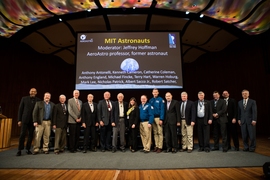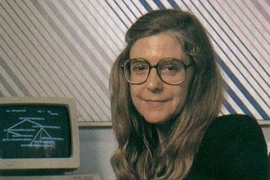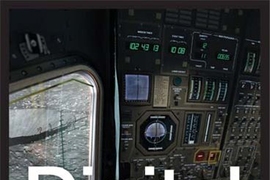Fifty years ago this week, humanity made its first expedition to another world, when Apollo 11 touched down on the moon and two astronauts walked on its surface. That moment changed the world in ways that still reverberate today.
MIT’s deep and varied connections to that epochal event — many of which have been described on MIT News — began years before the actual landing, when the MIT Instrumentation Laboratory (now Draper) signed the very first contract to be awarded for the Apollo program after its announcement by President John F. Kennedy in 1961. The Institute’s involvement continued throughout the program — and is still ongoing today.
MIT’s role in creating the navigation and guidance system that got the mission to the moon and back has been widely recognized in books, movies, and television series. But many other aspects of the Institute’s involvement in the Apollo program and its legacy, including advances in mechanical and computational engineering, simulation technology, biomedical studies, and the geophysics of planet formation, have remained less celebrated.
Amid the growing chorus of recollections in various media that have been appearing around this 50th anniversary, here is a small collection of bits and pieces about some of the unsung heroes and lesser-known facts from the Apollo program and MIT’s central role in it.
A new age in electronics
The computer system and its software that controlled the spacecraft — called the Apollo Guidance Computer and designed by the MIT Instrumentation Lab team under the leadership of Eldon Hall — were remarkable achievements that helped push technology forward in many ways.
The AGC’s programs were written in one of the first-ever compiler languages, called MAC, which was developed by Instrumentation Lab engineer Hal Laning. The computer itself, the 1-cubic-foot Apollo Guidance Computer, was the first significant use of silicon integrated circuit chips and greatly accelerated the development of the microchip technology that has gone on to change virtually every consumer product.
In an age when most computers took up entire climate-controlled rooms, the compact AGC was uniquely small and lightweight. But most of its “software” was actually hard-wired: The programs were woven, with tiny donut-shaped metal “cores” strung like beads along a set of wires, with a given wire passing outside the donut to represent a zero, or through the hole for a 1. These so-called rope memories were made in the Boston suburbs at Raytheon, mostly by women who had been hired because they had experience in the weaving industry. Once made, there was no way to change individual bits within the rope, so any change to the software required weaving a whole new rope, and last-minute changes were impossible.
As David Mindell, the Frances and David Dibner Professor of the History of Engineering and Manufacturing, points out in his book “Digital Apollo,” that system represented the first time a computer of any kind had been used to control, in real-time, many functions of a vehicle carrying human beings — a trend that continues to accelerate as the world moves toward self-driving vehicles. Right after the Apollo successes, the AGC was directly adapted to an F-8 fighter jet, to create the first-ever fly-by-wire system for aircraft, where the plane’s control surfaces are moved via a computer rather than direct cables and hydraulic systems. This approach is now widespread in the aerospace industry, says John Tylko, who teaches MIT’s class 16.895J (Engineering Apollo: The Moon Project as a Complex System), which is taught every other year.
As sophisticated as the computer was for its time, computer users today would barely recognize it as such. Its keyboard and display screen looked more like those on a microwave oven than a computer: a simple numeric keypad and a few lines of five-digit luminous displays. Even the big mainframe computer used to test the code as it was being developed had no keyboard or monitor that the programmers ever saw. Programmers wrote their code by hand, then typed it onto punch cards — one card per line — and handed the deck of cards to a computer operator. The next day, the cards would be returned with a printout of the program’s output. And in this time long before email, communications among the team often relied on handwritten paper notes.
Priceless rocks
MIT’s involvement in the geophysical side of the Apollo program also extends back to the early planning stages — and continues today. For example, Professor Nafi Toksöz, an expert in seismology, helped to develop a seismic monitoring station that the astronauts placed on the moon, where it helped lead to a greater understanding of the moon’s structure and formation. “It was the hardest work I have ever done, but definitely the most exciting,” he has said.
Toksöz says that the data from the Apollo seismometers “changed our understanding of the moon completely.” The seismic waves, which on Earth continue for a few minutes, lasted for two hours, which turned out to be the result of the moon’s extreme lack of water. “That was something we never expected, and had never seen,” he recalls.
The first seismometer was placed on the moon’s surface very shortly after the astronauts landed, and seismologists including Toksöz started seeing the data right away — including every footstep the astronauts took on the surface. Even when the astronauts returned to the lander to sleep before the morning takeoff, the team could see that Buzz Aldrin ScD ’63 and Neil Armstrong were having a sleepless night, with every toss and turn dutifully recorded on the seismic traces.
MIT Professor Gene Simmons was among the first group of scientists to gain access to the lunar samples as soon as NASA released them from quarantine, and he and others in what is now the Department of Earth, Planetary and Atmospheric Sciences (EAPS) have continued to work on these samples ever since. As part of a conference on campus, he exhibited some samples of lunar rock and soil in their first close-up display to the public, where some people may even have had a chance to touch the samples.
Others in EAPS have also been studying those Apollo samples almost from the beginning. Timothy Grove, the Robert R. Shrock Professor of Earth and Planetary Sciences, started studying the Apollo samples in 1971 as a graduate student at Harvard University, and has been doing research on them ever since. Grove says that these samples have led to major new understandings of planetary formation processes that have helped us understand the Earth and other planets better as well.
Among other findings, the rocks showed that ratios of the isotopes of oxygen and other elements in the moon rocks were identical to those in terrestrial rocks but completely different than those of any meteorites, proving that the Earth and the moon had a common origin and leading to the hypothesis that the moon was created through a giant impact from a planet-sized body. The rocks also showed that the entire surface of the moon had likely been molten at one time. The idea that a planetary body could be covered by an ocean of magma was a major surprise to geologists, Grove says.
Many puzzles remain to this day, and the analysis of the rock and soil samples goes on. “There’s still a lot of exciting stuff” being found in these samples, Grove says.
Sorting out the facts
In the spate of publicity and new books, articles, and programs about Apollo, inevitably some of the facts — some trivial, some substantive — have been scrambled along the way. “There are some myths being advanced,” says Tylko, some of which he addresses in his “Engineering Apollo” class. “People tend to oversimplify” many aspects of the mission, he says.
For example, many accounts have described the sequence of alarms that came from the guidance computer during the last four minutes of the mission, forcing mission controllers to make the daring decision to go ahead despite the unknown nature of the problem. But Don Eyles, one of the Instrumentation Lab’s programmers who had written the landing software for the AGC, says that he can’t think of a single account he’s read about that sequence of events that gets it entirely right. According to Eyles, many have claimed the problem was caused by the fact that the rendezvous radar switch had been left on, so that its data were overloading the computer and causing it to reboot.
But Eyles says the actual reason was a much more complex sequence of events, including a crucial mismatch between two circuits that would only occur in rare circumstances and thus would have been hard to detect in testing, and a probably last-minute decion to put a vital switch in a position that allowed it to happen. Eyles has described these details in a memoir about the Apollo years and in a technical paper available online, but he says they are difficult to summarize simply. But he thinks the author Norman Mailer may have come closest, capturing the essence of it in his book “Of a Fire on the Moon,” where he describes the issue as caused by a “sneak circuit” and an “undetectable” error in the onboard checklist.
Some accounts have described the AGC as a very limited and primitive computer compared to today’s average smartphone, and Tylko acknowledges that it had a tiny fraction of the power of today’s smart devices — but, he says, “that doesn’t mean they were unsophisticated.” While the AGC only had about 36 kilobytes of read-only memory and 2 kilobytes of random-access memory, “it was exceptionally sophisticated and made the best use of the resources available at the time,” he says.
In some ways it was even ahead of its time, Tylko says. For example, the compiler language developed by Laning along with Ramon Alonso at the Instrumentation Lab used an architecture that he says was relatively intuitive and easy to interact with. Based on a system of “verbs” (actions to be performed) and “nouns” (data to be worked on), “it could probably have made its way into the architecture of PCs,” he says. “It’s an elegant interface based on the way humans think.”
Some accounts go so far as to claim that the computer failed during the descent and astronaut Neil Armstrong had to take over the controls and land manually, but in fact partial manual control was always part of the plan, and the computer remained in ultimate control throughout the mission. None of the onboard computers ever malfunctioned through the entire Apollo program, according to astronaut David Scott SM ’62, who used the computer on two Apollo missions: “We never had a failure, and I think that is a remarkable achievement.”
Behind the scenes
At the peak of the program, a total of about 1,700 people at MIT’s Instrumentation Lab were working on the Apollo program’s software and hardware, according to Draper, the Instrumentation Lab’s successor, which spun off from MIT in 1973. A few of those, such as the near-legendary “Doc” Draper himself — Charles Stark Draper ’26, SM ’28, ScD ’38, former head of the Department of Aeronautics and Astronautics (AeroAstro) — have become widely known for their roles in the mission, but most did their work in near-anonymity, and many went on to entirely different kinds of work after the Apollo program’s end.
Margaret Hamilton, who directed the Instrumentation Lab’s Software Engineering Division, was little known outside of the program itself until an iconic photo of her next to the original stacks of AGC code began making the rounds on social media in the mid 2010s. In 2016, when she was awarded the Presidential Medal of Freedom by President Barack Obama, MIT Professor Jaime Peraire, then head of AeroAstro, said of Hamilton that “She was a true software engineering pioneer, and it’s not hyperbole to say that she, and the Instrumentation Lab’s Software Engineering Division that she led, put us on the moon.” After Apollo, Hamilton went on to found a software services company, which she still leads.
Many others who played major roles in that software and hardware development have also had their roles little recognized over the years. For example, Hal Laning ’40, PhD ’47, who developed the programming language for the AGC, also devised its executive operating system, which employed what was at the time a new way of handling multiple programs at once, by assigning each one a priority level so that the most important tasks, such as controlling the lunar module’s thrusters, would always be taken care of. “Hal was the most brilliant person we ever had the chance to work with,” Instrumentation Lab engineer Dan Lickly told MIT Technology Review. And that priority-driven operating system proved crucial in allowing the Apollo 11 landing to proceed safely in spite of the 1202 alarms going off during the lunar descent.
While the majority of the team working on the project was male, software engineer Dana Densmore recalls that compared to the heavily male-dominated workforce at NASA at the time, the MIT lab was relatively welcoming to women. Densmore, who was a control supervisor for the lunar landing software, told The Wall Street Journal that “NASA had a few women, and they kept them hidden. At the lab it was very different,” and there were opportunities for women there to take on significant roles in the project.
Hamilton recalls the atmosphere at the Instrumentation Lab in those days as one of real dedication and meritocracy. As she told MIT News in 2009, “Coming up with solutions and new ideas was an adventure. Dedication and commitment were a given. Mutual respect was across the board. Because software was a mystery, a black box, upper management gave us total freedom and trust. We had to find a way and we did. Looking back, we were the luckiest people in the world; there was no choice but to be pioneers.”















